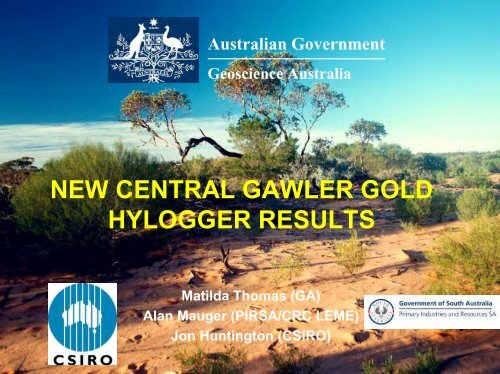Tunkillia Hylogger Diamond Holes #1 - Geoscience Australia
Tunkillia Hylogger Diamond Holes #1 - Geoscience Australia
Tunkillia Hylogger Diamond Holes #1 - Geoscience Australia
Create successful ePaper yourself
Turn your PDF publications into a flip-book with our unique Google optimized e-Paper software.
<strong>Australia</strong>n Government<br />
<strong>Geoscience</strong> <strong>Australia</strong><br />
NEW CENTRAL GAWLER GOLD<br />
HYLOGGER RESULTS<br />
Matilda Thomas (GA)<br />
Alan Mauger (PIRSA/CRC LEME)<br />
Jon Huntington (CSIRO)<br />
Matilda Thomas <strong>Hylogger</strong> presentation Feb 2006<br />
<strong>Geoscience</strong> <strong>Australia</strong>
Matilda Thomas <strong>Hylogger</strong> presentation Feb 2006<br />
<strong>Geoscience</strong> <strong>Australia</strong><br />
Preliminary results from the <strong>Tunkillia</strong> region<br />
Central Gawler Gold Prospect<br />
South <strong>Australia</strong><br />
<strong>Hylogger</strong> project collaborators/developers:<br />
CSIRO MMTG (Jon Huntington et al…)<br />
PIRSA/CRC LEME (Alan Mauger, John Keeling and Georgina Gordon)<br />
<strong>Geoscience</strong> <strong>Australia</strong> (Matilda Thomas)
<strong>Hylogger</strong> background<br />
• Developed by CSIRO’s Mineral<br />
Mapping Technologies Group<br />
• Automated core tray<br />
handling, digital imaging<br />
and spectral scanning<br />
can log up to 1000 m of<br />
core per day (more for<br />
chips)<br />
• Specialised mineral<br />
identification software<br />
for rapid logging<br />
capability<br />
Matilda Thomas <strong>Hylogger</strong> presentation Feb 2006<br />
<strong>Geoscience</strong> <strong>Australia</strong>
Matilda Thomas <strong>Hylogger</strong> presentation Feb 2006<br />
<strong>Geoscience</strong> <strong>Australia</strong><br />
Continuous VNIR-SWIR hyperspectral scanner and digital<br />
imager (~1cm spectral resolution, ~0.1mm image resolution)
Matilda Thomas <strong>Hylogger</strong> presentation Feb 2006<br />
<strong>Geoscience</strong> <strong>Australia</strong><br />
The contiguous spectrum (similar to PIMA and HyMap)<br />
allows detailed information to be extracted from the spectra<br />
–
<strong>Hylogger</strong> interpretation challenges<br />
• processing approach and methodology –<br />
where to start, what to mask, etc.<br />
• software bugs – “cutting edge” technology =<br />
undiscovered bugs lurking at every corner<br />
• software version changes – several versions<br />
released since start of project, some<br />
problems opening previously processed<br />
data in newer versions<br />
• Export to other formats, display options or<br />
lack thereof …<br />
Matilda Thomas <strong>Hylogger</strong> presentation Feb 2006<br />
<strong>Geoscience</strong> <strong>Australia</strong>
Matilda Thomas <strong>Hylogger</strong> presentation Feb 2006<br />
<strong>Geoscience</strong> <strong>Australia</strong><br />
Spectral unmixing generally allows up to 4 minerals to be<br />
identified, also non-minerals such as wood, plastic markers,<br />
metal trays, etc., which can then be “masked out”
Matilda Thomas <strong>Hylogger</strong> presentation Feb 2006<br />
<strong>Geoscience</strong> <strong>Australia</strong><br />
<strong>Tunkillia</strong>
Location of <strong>Tunkillia</strong><br />
Location of drill holes in area 223<br />
Matilda Thomas <strong>Hylogger</strong> presentation Feb 2006<br />
Figures from Worral et.al 2003<br />
<strong>Geoscience</strong> <strong>Australia</strong>
LED_001<br />
LED_002<br />
LED_003<br />
LED_004<br />
LED_005<br />
LED_006<br />
LED_007<br />
LED_008<br />
<strong>#1</strong><br />
#2<br />
#3<br />
#4<br />
#5<br />
<strong>Tunkillia</strong><br />
<strong>Diamond</strong><br />
<strong>Holes</strong><br />
Au assay data<br />
(Blue = 0ppm to<br />
Red = >3ppm)<br />
LED_010<br />
LRC_019<br />
LRC_272<br />
Matilda Thomas <strong>Hylogger</strong> presentation Feb 2006<br />
} Outside<br />
mineralised zone<br />
<strong>Geoscience</strong> <strong>Australia</strong>
<strong>Tunkillia</strong> <strong>Hylogger</strong> <strong>Diamond</strong> <strong>Holes</strong> <strong>#1</strong><br />
Matilda Thomas <strong>Hylogger</strong> presentation Feb 2006<br />
<strong>Geoscience</strong> <strong>Australia</strong><br />
1.<br />
Log Au<br />
2.<br />
Al(OH)<br />
3. Mica<br />
wavelegnth<br />
4. Mica<br />
wavelegnth<br />
5. Chlorite<br />
/Epidote
<strong>Tunkillia</strong> <strong>Hylogger</strong> <strong>Diamond</strong> <strong>Holes</strong> <strong>#1</strong><br />
Matilda Thomas <strong>Hylogger</strong> presentation Feb 2006<br />
<strong>Geoscience</strong> <strong>Australia</strong><br />
Au>3ppm<br />
Au=0<br />
Muscovite<br />
Phengite<br />
2220nm<br />
2210nm<br />
2200nm<br />
Au>3ppm<br />
Au=0<br />
Au>3ppm<br />
Au=0
“Transitional” white mica spectra –<br />
between muscovite and phengite,<br />
diagnostic absorption feature at ~2210nm<br />
Matilda Thomas <strong>Hylogger</strong> presentation Feb 2006<br />
<strong>Geoscience</strong> <strong>Australia</strong>
White mica chemistry and relation to fluids<br />
Figure courtesy PlacerDome/ Simon van de Wielen<br />
Matilda Thomas <strong>Hylogger</strong> presentation Feb 2006<br />
<strong>Geoscience</strong> <strong>Australia</strong>
<strong>Tunkillia</strong> <strong>Hylogger</strong> <strong>Diamond</strong> <strong>Holes</strong> <strong>#1</strong><br />
Matilda Thomas <strong>Hylogger</strong> presentation Feb 2006<br />
<strong>Geoscience</strong> <strong>Australia</strong><br />
Au>3ppm<br />
Au=0<br />
Muscovite<br />
Phengite<br />
2220nm<br />
2210nm<br />
2200nm<br />
Au>3ppm<br />
Au=0<br />
Au>3ppm<br />
Au=0
Matilda Thomas <strong>Hylogger</strong> presentation Feb 2006<br />
<strong>Geoscience</strong> <strong>Australia</strong><br />
Plots delineate mafic dykes − chlorite/epidote generally<br />
inverse relationship to Au, exceptions at margins
<strong>Tunkillia</strong> <strong>Hylogger</strong> <strong>Diamond</strong> <strong>Holes</strong> #2<br />
Matilda Thomas <strong>Hylogger</strong> presentation Feb 2006<br />
<strong>Geoscience</strong> <strong>Australia</strong><br />
Au>3ppm<br />
Au=0<br />
Muscovite<br />
Phengite<br />
2220nm<br />
2210nm<br />
2200nm<br />
Au>3<br />
Au=0<br />
Au>3<br />
Au=0
<strong>Tunkillia</strong> <strong>Hylogger</strong> <strong>Diamond</strong> <strong>Holes</strong> #3<br />
Matilda Thomas <strong>Hylogger</strong> presentation Feb 2006<br />
<strong>Geoscience</strong> <strong>Australia</strong><br />
Au>3ppm<br />
Au=0<br />
Muscovite<br />
Phengite<br />
2220nm<br />
2210nm<br />
2200nm<br />
Au>3<br />
Au=0<br />
Au>3<br />
Au=0
<strong>Tunkillia</strong> <strong>Hylogger</strong> <strong>Diamond</strong> <strong>Holes</strong> #4<br />
Matilda Thomas <strong>Hylogger</strong> presentation Feb 2006<br />
<strong>Geoscience</strong> <strong>Australia</strong><br />
Au>3ppm<br />
Au=0<br />
Muscovite<br />
Phengite<br />
2220nm<br />
2210nm<br />
2200nm<br />
Au>3<br />
Au=0<br />
Au>3<br />
Au=0
Matilda Thomas <strong>Hylogger</strong> presentation Feb 2006<br />
<strong>Geoscience</strong> <strong>Australia</strong><br />
<strong>Tunkillia</strong> <strong>Hylogger</strong> <strong>Diamond</strong> <strong>Holes</strong> #5<br />
Au>3ppm<br />
Au=0<br />
Muscovite<br />
Phengite<br />
2220nm<br />
2210nm<br />
2200nm<br />
Au>3<br />
Au=0<br />
Au>3<br />
Au=0
Matilda Thomas <strong>Hylogger</strong> presentation Feb 2006<br />
<strong>Geoscience</strong> <strong>Australia</strong><br />
<strong>Tunkillia</strong> <strong>Hylogger</strong> <strong>Diamond</strong> <strong>Holes</strong> #6
Matilda Thomas <strong>Hylogger</strong> presentation Feb 2006<br />
<strong>Geoscience</strong> <strong>Australia</strong><br />
<strong>Hylogger</strong> Atlas<br />
contact sheets,<br />
summary<br />
histograms,<br />
interpreted<br />
mineralogy<br />
available on web<br />
– soon!
Matilda Thomas <strong>Hylogger</strong> presentation Feb 2006<br />
<strong>Geoscience</strong> <strong>Australia</strong><br />
Conclusions<br />
• High Au shows some correlation with white mica<br />
composition (phengite-muscovite) as well as mica<br />
crystallinity and wavelength shifts, possibly<br />
representing an increasing in acidity due to<br />
mixing of metamorphic muscovite and<br />
hydrothermal fluid in the altered granitic host<br />
rocks<br />
• Alteration in mafic dykes − chlorite-carbonate well<br />
delineated<br />
• Au predominantly confined to granite host, high<br />
Au in mafic areas appears to occur on margins /<br />
fracture zones
Acknowledgements<br />
Processing guidance and advice<br />
Special thanks to Alan Mauger and Georgina Gordon<br />
(PIRSA)<br />
Peter Mason and Jon Huntington (CSIRO)<br />
Project support and interpretation<br />
Roger Skirrow, Simon van de Wielen<br />
and Lindsay Highet (GA)<br />
Matilda Thomas <strong>Hylogger</strong> presentation Feb 2006<br />
<strong>Geoscience</strong> <strong>Australia</strong>

















